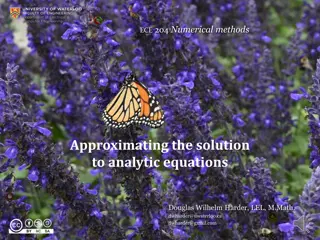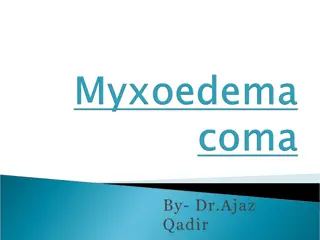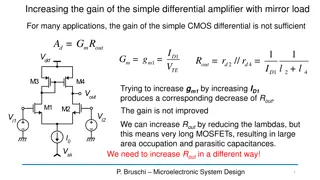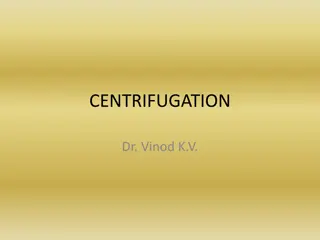Transfusion
Blood transfusion is a crucial medical procedure worldwide, with various components like packed red blood cells, plasma, platelets, and cryoprecipitate being utilized for efficient use. Differential centrifugation is employed for component preparation, ensuring precise separation of red blood cells,
2 views • 45 slides
Differential white blood cell count
Differential white blood cell count, also known as a leukocyte count, is a crucial test to determine the different types of white blood cells present in the blood. The cells are classified into granulocytes (neutrophils, eosinophils, basophils) and agranulocytes (lymphocytes, monocytes). Blood smear
3 views • 21 slides
Approach to Depression in Primary Care by Dr. Jon Davine
In this presentation, Dr. Jon Davine discusses the approach to depression in primary care, covering topics such as differential diagnosis, antidepressant medication selection, augmentation techniques, and treatment options like ECT and TMS. The sad state is explored through differential diagnoses, i
5 views • 56 slides
Understanding Numerical Methods for Approximating Analytic Equations
Introduction to approximating solutions to analytic equations, focusing on differential equations, integral equations, and integro-differential equations. Exploring ordinary and partial derivatives, differential and integral equations, and the involvement of unknown functions and their derivatives a
2 views • 15 slides
Understanding Blood Transfusion: Components, Preparation, and Safety Measures
Blood transfusion is a crucial medical procedure involving the transfusion of different blood components to patients in need. This practice has evolved to include various components such as packed red blood cells, plasma, platelets, and more. The preparation of these components involves specific tec
1 views • 45 slides
Exploring Genetics and Genomics in Integrative Biology
Delve into the world of genetics and genomics through the lens of integrative biology, investigating the differences between cell types, the rationale for gene expression profiling, and the analysis of differential gene expression in various diseases. Uncover the significance of gene ontology, co-ex
0 views • 22 slides
Understanding Downstream Processing in Bioprocessing
Downstream processing plays a crucial role in bioprocessing after fermentation, focusing on separating, purifying, and packaging the final product. It involves stages like cell disruption, removal of insoluble particles, product recovery, and purification methods such as filtration and centrifugatio
0 views • 38 slides
Understanding Central Abdominal Pain and Masses in Clinical Practice
Abdominal pain evaluation involves considering various differential diagnoses such as appendicitis, small bowel obstruction, and mesenteric ischemia. By categorizing pain as visceral, parietal, referred, or radiating, healthcare providers can better understand the underlying pathology. The history o
0 views • 57 slides
Differential Equations of First Order & Higher Degree: Lecture 18
This lecture covers differential equations of first order but not of the first degree, general forms of such equations, methods for solving them, and examples of differential equations to be solved. The content includes detailed explanations, equations, solutions, and problem-solving techniques.
0 views • 9 slides
Understanding Differential Leucocyte Count for Blood Disorders
Differential Leucocyte Count (DLC) is crucial for diagnosing blood-related disorders by analyzing the distribution and morphology of white blood cells. Dr. Versha Prasad explains the significance, normal values, and various conditions like neutrophilia, lymphocytosis, monocytosis, and basophilia. Th
1 views • 15 slides
Understanding WBC Differential Count in Blood Analysis
WBC (white blood cell) count is essential in assessing a patient's health. A differential count helps determine the percentage of different types of white blood cells. This analysis can provide important insights into various health conditions like infections, allergies, and systemic illnesses. The
1 views • 9 slides
Understanding Myxedema Coma: Symptoms, Diagnosis, and Management
Myxedema coma is a rare, life-threatening condition associated with decompensated hypothyroidism. It presents with altered mental status, low body temperature, and various metabolic abnormalities. This article explores the primary symptoms, differential diagnosis, and management of myxedema coma bas
0 views • 20 slides
Understanding Colloids and Their Importance in Pharmaceuticals
Colloids play a vital role in the pharmaceutical industry as heterogeneous biphasic systems with particle sizes ranging from 1nm to 100nm. They are classified based on aggregation and interaction of phases, with examples like aerosols, foams, emulsions, and more. Colloids can be prepared by condensa
0 views • 23 slides
Understanding Differential Leveling in Surveying
Differential leveling is a crucial aspect of surveying that involves determining the elevation of points with respect to a reference datum. This process includes various key elements such as benchmark, back sight, fore sight, and change points. By utilizing methods like the Height of Instrument and
1 views • 12 slides
Techniques to Increase Gain in a Simple Differential Amplifier
Explore methods to boost the gain of a simple CMOS differential amplifier by replacing the current mirror with a cascode mirror, adding a common-gate stage, and employing a cascode differential amplifier. These techniques help improve Rout without extensive use of long MOSFETs, optimizing the amplif
2 views • 30 slides
Understanding Differential Equations: Types, Classification, and Solutions
Differential equations are mathematical equations that relate independent and dependent variables through differential coefficients. They can be classified as ordinary or partial, based on the types of derivatives involved. The order and degree of a differential equation, as well as its linearity an
3 views • 26 slides
Understanding Differential Equations in Economics Honours
Differential equations, introduced by Newton and Leibniz in the 17th century, play a key role in economics. These equations involve derivatives and represent implicit functional relationships between variables and their differentials, often related to time functions. The order and degree of a differ
1 views • 16 slides
Introduction to Differential Equations and Laplace Equations
Understanding differential equations of various orders, solving methods, linear and non-linear equations, ordinary and partial differential equations, definitions of solutions, and general vs. particular solutions in the context of Differential Equations and Laplace Equations.
1 views • 20 slides
Understanding the Applications and Design of Analytical Ultracentrifugation
Analytical ultracentrifugation, a powerful technique in biochemistry, allows for precise measurement of sample properties and characterization of macromolecular complexes. The method is widely used for determining sample purity, equilibrium constants, and assembly mechanisms of biological complexes.
1 views • 17 slides
Separating Components of Ternary Mixtures: Experiment and Methods
Experiment aims to separate sand, sodium chloride, and calcium carbonate in a mixture to calculate percentages and recovery. Explore various methods like chromatography, distillation, extraction, centrifugation, crystallization, and sublimation for component separation.
1 views • 30 slides
Principles and Applications of Centrifugation in Microtomy and Microscopy
Centrifugation is a process that separates substances based on density using high-speed rotation. This article explores the basic principles of centrifugation, instrumentation, and applications in the fields of microtomy and microscopy. It covers the different types of centrifuges, such as low-speed
0 views • 28 slides
Overview of Virology Methods: Cultivation, Isolation, Purification
Various methods are employed in virology, including virus cultivation in different cells, virus isolation, and virus purification through centrifugation. Structural investigations, virion component-based techniques, and virus infectivity-based techniques are also common in virology research. Underst
0 views • 15 slides
Cellular Fractionation: Techniques and Applications
Cellular fractionation is a crucial process for separating cellular components to study intracellular structures and proteins. It involves homogenization, centrifugation, and purification steps to isolate organelles based on their properties like density and shape. This method provides valuable insi
6 views • 11 slides
Exploring Downstream Processing in Biotechnology for Product Recovery and Purification
Downstream processing in biotechnology involves the recovery and purification of biosynthetic products like pharmaceuticals from natural sources, using techniques such as filtration, centrifugation, and flocculation. This process is crucial in manufacturing antibiotics, hormones, antibodies, vaccine
1 views • 25 slides
Understanding Packed Cell Volume (PCV) in Blood Analysis
Packed Cell Volume (PCV), also known as hematocrit, is a crucial parameter in blood analysis that indicates the relative proportion of red blood cells to plasma. It is used for detecting anemia, polycythemia, and assessing red cell indices. The Wintrobe method is commonly employed to measure PCV, in
0 views • 9 slides
Understanding Centrifugation: Industrial and Laboratory Applications
Centrifugation is a procedure that utilizes centrifugal force to separate components based on density in mixtures for both industrial and laboratory purposes. This process involves the rotation of particles at high speeds to induce sedimentation. Different types of centrifuges, such as low-speed and
0 views • 18 slides
Controlling Microorganisms in Milk for Quality and Safety
Raw milk contains various microorganisms, and efficient cooling to 4°C post-milking is essential. Heat treatment methods like pasteurization, ultrapasteurization, and UHT processing help control bacterial numbers. Techniques such as centrifugation, filtration, and additional methods like carbon dio
0 views • 9 slides
Understanding Differential Equations in Physical Phenomena
Differential equations play a crucial role in modeling physical phenomena involving rates of change like fluid motion, mechanical systems, and heat dissipation. This content explores examples of differential equations in motion and provides insights on sketching direction fields using tools like Map
0 views • 11 slides
Validation Study of Rapeseed Oil Body Extraction Methods
This study explores the validation of two rapeseed oil body extraction methods. It delves into the common uses of rapeseed, the components of oil bodies, and their potential applications in the human food system. The materials and methods section details the extraction processes, including dry and w
2 views • 23 slides
Exploring SymDiff: A Differential Program Verifier
SymDiff is a platform that leverages program verification to analyze program differences, focusing on differential verification to verify properties of program variances rather than the program itself. The architecture, language subset, and modeling imperative programs/heaps are key components discu
1 views • 18 slides
Understanding CMRR in Differential Amplifiers
Differential input amplifiers, including operational, instrumentation, and difference amplifiers, play a crucial role in amplifying differential signals while rejecting common-mode noise. The Common-Mode Rejection Ratio (CMRR) is a key parameter in these amplifiers, indicating their ability to suppr
0 views • 48 slides
Applications of Differential Equations in Engineering and Mathematics
Exploring the practical applications of differential equations, specifically focusing on Newton's Law of Cooling and Orthogonal Trajectories. The concept of exact differential equations and their solutions, along with real-life examples demonstrating temperature changes over time, are discussed. Und
0 views • 11 slides
Validation of Replacement Method for Clinical CD34+ Cell Purification
Urgent validation of a replacement method for clinical CD34+ cell purification is required due to the discontinuation of COBE 2991 and CliniMACS I in 2023. Options include using CliniMACS II with an alternative cell washer or the Miltenyi Prodigy system. An optimized thaw method may allow for the re
0 views • 12 slides
Biochemical Methodology 530 - Lactate Dehydrogenase Extraction and Purification Experiment
This course focuses on the extraction and purification of lactate dehydrogenase (LDH) using a series of procedures involving tissue preparation, centrifugation, and ammonium sulfate precipitation. The methodology includes detailed steps from preparing the extraction buffer to isolating LDH in differ
0 views • 10 slides
Understanding MitoCarta and Naive Bayes Integration in Excel Tutorial
Explore the process of calculating Naive Bayes log-odds scores and ROC curves in Excel using the MitoCarta dataset. Discover the best experimental techniques for isolating mitochondria in Arabidopsis studies, comparing methods like differential centrifugation and affinity purification.
0 views • 31 slides
Understanding Differential Privacy in Statistical Analysis
Gain insight into the concept of differential privacy in statistical analysis through key terminologies, foundational ideas, and practical examples. Explore the balance between data privacy and statistical quality, and learn how differential privacy serves as a mathematical guarantee to protect indi
1 views • 28 slides
DNA Extraction from Blood: Methods and Protocol
Studying DNA is crucial for disease prevention, diagnosis, and treatment. This guide provides a step-by-step protocol for extracting DNA from blood, involving procedures like cell lysis, protein and RNA removal, DNA precipitation, and final nucleic acid determination. Key steps include using reagent
0 views • 6 slides
Dynamic Function for Basal Area of Trees Derived from Differential Equation
Mathematical methods presented by Braun and Simmons are used to derive a dynamic function for the basal area of individual trees from a production-theoretically motivated autonomous differential equation. The differential equation and general dynamic function are described, highlighting the relation
0 views • 45 slides
Solving Differential Equations: Methods and Techniques
Learn how to solve differential equations using methods like separation of variables and sketch families of solution curves. Understand the process of finding general and particular solutions to equations, and explore a variety of exercises and examples to enhance your understanding. Master the art
0 views • 16 slides
The Challenges of Protecting Privacy with Differential Privacy
The article discusses the motivation behind using differential privacy to protect sensitive data while enabling useful queries. It highlights the promise of differential privacy, challenges faced, attacks on existing systems like PINQ and Airavat, and introduces a defense system called The Fuzz. The
0 views • 24 slides







































